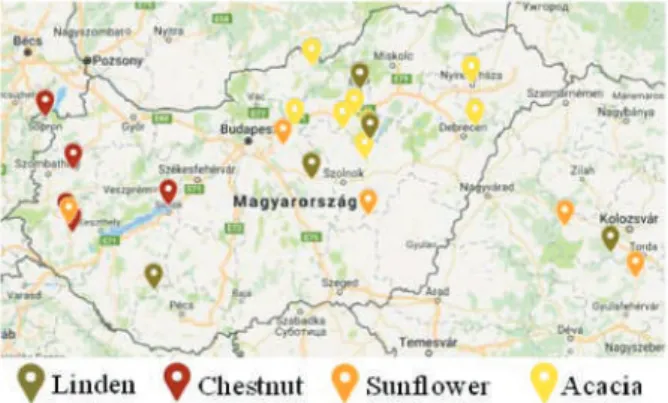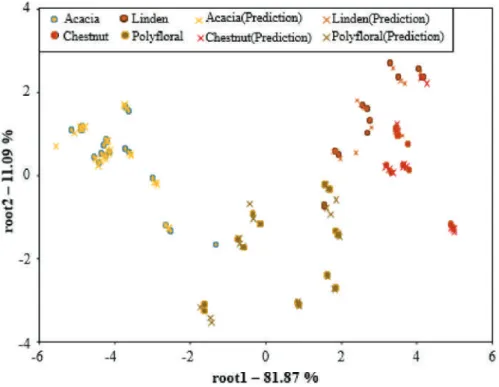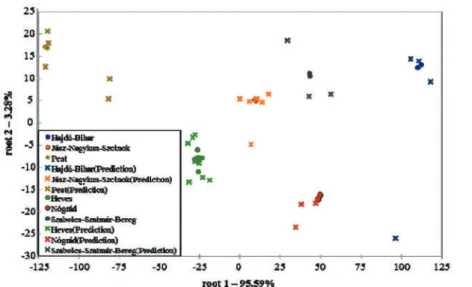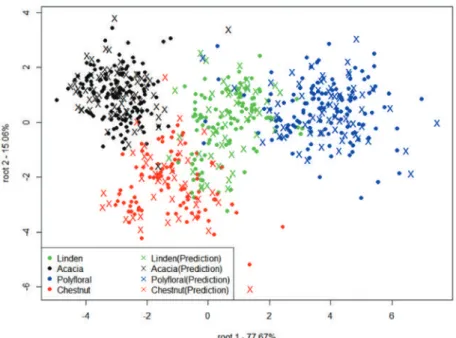Abstract
As one of the most often used natural sweeteners, honey has recently been reconsidered and more commonly used. Although Hungary is one of the main honey exporter countries, data referring to Hungarian honeys is very limited. Our aim was to investigate the analytical, physical and rheological properties of different honey samples and use these attributes to identify their geographical and botanical origin. Our results show the application of colorimetry, analytical and rheological measurements might be a promising combination of affordable methods for authentication of honey origin, however, further experiments are proposed to build up a robust database.
Keywords
honey, polyphenols, colorimetry, rheology, near- infrared spectroscopy
1. Introduction
The latest trends in nutrition shows towards the consumption of more natural and less processed food products, for instance honey. It is produced by honeybees (Apis mellifera) either from nectar, sap of plan parts or from the juicy material secreted by sucking insects. Honey is also a particularly valuable product because it is rich in nutritional components like vitamins, minerals, organic acids, proteins, and amino acids. Furthermore, every kind of honey or honeydew has a specific aroma, flavor and scent [1].
The quality of honey highly depends on its botanical
and geographical origin [2]. Physico-chemical and sensory properties of honey vary based on their origin [3][4]. Although Hungary is one of the main honey exporter countries, data referring to Hungarian honeys is very limited.
However, honey has been also target of food adulteration due to its emerging use and relatively high price. Methods for adulteration have a wide range from feeding bees with different kinds of sugar syrups to blending European honey with cheaper honey from different countries or with syrups like high fructose corn syrup (HFCS), beet syrup, or rice syrup [5]. Authorities and scientists apply different methods to detect adulteration, for example high- liquid chromatography (HPLC), gas chromatography/
mass spectrometry (GC/MS), atomic emission spectroscopy (AES), nuclear magnetic resonance spectroscopy (NMR), etc. [5][6]. These methods are time-consuming and need very strict controlled operation criteria [7]. They also need high-cost instruments which are usually non-portable and need highly qualified, trained persons [8]. Therefore, there is an increasing need to develop rapid evaluation methods for identification of honey from different sources. Determination of parameters such as ash content, electrical conductivity, pH, color [9][10] and near infrared spectra [11][12] can be a good way to estimate the origin of honey and also for tracing quality [13][14]. Rheological properties of honey may also depend on the floral source [15]. The measurement of the total polyphenol content (TPC) is also a well-known method for the determination of floral or geographical origin of honey [9][16].
However, the determination of individual parameters does not always provide satisfactory accuracy for
HUNGARIAN AGRICULTURAL ENGINEERING N° 32/2017 22-28
Published online: http://hae-journals.org/
HU ISSN 0864-7410 (Print) / HU ISSN 2415-9751(Online) DOI: 10.17676/HAE.2017.32.22
CLASSIFICATION MODELS OF HUNGARIAN HONEY SAMPLES BASED ON ANALYTICAL AND PHYSICAL CHARACTERISTICS
Author(s):
T. Kaszab1– Zs. Bodor2– Z. Kovacs1– Cs. Benedek2 Affiliation:
1Department of Physics and Control, Faculty of Food Science, Szent István University, Somlói út 14-16., Budapest, H-1118, Hungary
2Department of Dietetics and Nutrition, Faculty of Health Sciences, Semmelweis University, Vas u. 17., H-1088 Budapest, Hungary
Email address:
kaszab.timea@etk.szie.hu, zsanett.bodor93@gmail.com, zoltan.kovacs3@etk.szie.hu, benedek.csilla@se-etk.hu PERIODICAL OF THE COMITTEE OF
AGRICULTURAL AND BIOSYSTEM ENGINEERING OF
THE HUNGARIAN ACADEMY OF SCIENCES and
SZENT ISTVÁN UNIVERSITY Faculty of Mechanical Engineering Received: 2017.10.17. - Accepted: 2017.12.02.
origin identification or detection of adulteration.
Therefore, simultaneous measurement of main physical and chemical parameters of honey, combined with chemometric methods could be more efficient.
Our aim was to investigate the analytical, physical and rheological properties of honeys and to use these attributes to identify their geographical and botanical origin using appropriate statistical methods.
2. Materials and Methods Honey samples
In this study 29 honey samples were analysed with several methods explained in the Methods section (Figure 1). Most of the honey samples were collected directly from beekeepers.
Figure 1. Geographical origin of honeys
Honey samples are from different botanical origin such as acacia (10 samples), linden (6 samples), chestnut (5 samples) and polyfloral (8 samples).
Samples were collected from different geographical regions, most of them are from different parts of Hungary. Some samples were collected from Transylvania and 1 honey from the market, being labelled as a blend of honeys from the European Union and outside this.
Methods
Main physico-chemical parameters like ash content, pH, electrical conductivity, refraction index and total soluble dry material content of honey samples were determined according to the methods recommended by the International Honey Commission [17].
Ash content
Three to seven grams of honey sample was measured to a porcelain jars and two drops of olive oil were given in each jar. Then the samples were pre-
combusted with a gas burner and put in the electric furnace at 600 °C until constant weight was reached.
pH determination
1.333 g honey sample was weighted in and dissolved in 10 ml carbon dioxide-free distilled water and measured with a pH meter.
Electrical conductivity
An amount of honey, equivalent to 20.0 g anhydrous honey, was dissolved in distilled water, then it was transferred quantitatively to a 10 ml volumetric flask and made up to volume with distilled water. The electrical conductivity of the solution was measured.
Refractometry
Honeys were also analyzed using an Abbé refractometer to read their refractive index which provides information about the dry matter content of the sample using the tables of the International Honey Commission [17].
Total polyphenol content (TPC)
1 g of honey sample was measured in a 10 ml volumetric flask and made up to volume with distilled water. Total polyphenol content was determined by the Folin–Ciocalteu colorimetric method using gallic acid as a standard: 1ml of the honey sample solution was put in a test tube and 7.5 ml distilled water was added. Then 0.5 ml of the Folin–Ciocalteu reagent was given to each tube and after 3 minutes 1 ml Na2CO3solution was added. Absorbance was read on a Helios ɑ-spectrophotometer at 750 nm, after a 30 minutes incubation period [18].
Color determination
Honey samples were measured with a Konica Minolta 410 colorimeter in the CIE L*a*b* color space. This color system is a three-dimensional coordinate system which means that it gives us information on the color properties in three dimensions: L* (light-dark), a* (green-red) and b*
(blue-yellow).
Near infrared spectroscopy
The near infrared (NIR) spectra of the honey samples were collected with an Enterprise Tellspec Food Sensor g1 scanner (Tellspec Inc., Toronto, Ontario, Canada) in several sessions acquiring multiple spectra per sample in each session, with 2nm spectral step in the 950-1630 nm spectral interval. Reflectance
cuvette holder with 0.4 mm layer thickness was used during the data acquisition.
Rheology
RotoVisco1 rotational viscometer was applied to determine the shear stress of honey samples. The dynamical viscosity was calculated from the ratio of shear stress and shear velocity. Each sample was measured twice and the average values were evaluated. Each measurement includes three stages.
The stages were as the follows: accelerated shear velocity up to 100 1/s during 100s; mixing at the maximum velocity during 100s; slowing velocity from the maximum to zero during 100s.
Statistical evaluation
The evaluation of the combined data of the analytical, physical and rheological parameters, as well as the NIR results were analyzed by linear discriminant analysis (LDA) [19]. LDA is one of the most frequently used of parametric classification procedures. In the LDA the classification scores depend on the descriptive scores linearly, where the groups are defined previously. The tasks of the model
maximize the ratio between-class variance and minimize the ratio of within-class variance. LDA supposes a prior knowledge of the group membership of each sample in a training set. The classification power of the model derived evaluate by using the original grouped cases or using cross-validation procedure. LDA models were built for the botanical and geographical origin identification of the honey samples, separately. LDA models were validated using one sample-out cross-validation and the models of NIR data were additionally tested by independent prediction. R-Project, Microsoft Excel and XLSTAT software were used for the data evaluation.
3. Results and discussion
Results of the evaluation of analytical, colorimetric and rheological measurements
The results of LDA model built for the classification of the different floral types of honey such as acacia, chestnut and polyfloral honeys using the data of rheological, colorimetric and analytical parameters (total polyphenol content, ash content, pH, electrical conductivity and refractive index) are shown in Figure 2 and Table 1.
Figure 2. LDA score plots presenting the separation of the different floral groups of honey using rheological, colorimetric and analytical parameters (n=145)
The LDA model presented average recognition and prediction abilities of 89.29% and 90.48 %, respectively for the classification of acacia, chestnut, linden and polyfloral samples based on
their botanical origin as shown in more details in Table 1.
Classification models were also developed for the discrimination of the honey samples based on their
geographical origin by counties using the rheological, colorimetric and analytical parameters. Classification performance of the LDA model built for geographical origin identification provided average recognition and prediction abilities of 66.07 % and 79.76%, respectively, when data of all floral types were included.
Better results were obtained when separate models were built for the geographical origin identification of the individual honey types. In case of chestnut, polyfloral and linden honey types both recognition and prediction ability were found to be 100%. LDA model of acacia honey presented average recognition and prediction abilities of 100% and 80%, respectively (Table 2 and Figure 3).
Table 1. Confusion matrix of the LDA model built for the classification of the honey samples
by their botanical origin using rheological, colorimetric and analytical parameters (n=145)
Figure 3. LDA score plots presenting the separation of the different geographical groups of acacia honey using rheological, colorimetric and analytical parameters (n=50)
Table 2. Confusion matrix of the LDA model built for geographical origin classification of acacia honey using rheological, colorimetric and analytical parameters (n=50)
Results of the near infrared spectroscopy measurements
Results of LDA model built for the classification of the different honey samples based on their floral types such as linden, acacia, chestnut and polyfloral honeys based on their NIR spectra is presented in Figure 4.
The average recognition and prediction abilities of the NIR based model were found to be 95.65 % and 92.61%, respectively.
Classification of the honey samples based on their geographical origin using the NIR spectroscopic data
provided average recognition and prediction abilities of 99.13 % and 95.65%, respectively, when data of all floral types was included.
Similarly to the results of the rheological, colorimetric and analytical parameters, better results and further improvement of the identification of the geographical origin were possible when separate models were built for the individual honey types. In case of all the tested honey types, i.e. linden, acacia, polyfloral and chestnut honey types both recognition and prediction ability were found 100%
Figure 4. LDA score plots presenting the separation of the different floral groups of honey using data of near infrared spectroscopy in the range between 950 and 1630 nm (n=690)
4. Conclusion
Our results show that application of colorimetry, basic analytical and rheological measurements might be a promising combination of affordable methods for authentication of honey origin. Based on these first encouraging results, we propose further experiments to build up a robust database enlarging not only the geographical area, but also increasing the number of domestic honey samples. It also can be seen that these simple tools are also fairly reliable for the recognition of geographical origin identification if we build our models for individual honey types, this emphasizing the importance of characteristics determined by botanical origin over those influenced by the geographical origin.
According to our results, NIR spectroscopy applied on its own can also be an even more efficient method for honey classification based on botanical origin. A
special and very practical advantage of this latter is offered by non-destructive method needing no sample preparation and the portable instrument, qualifying thus this analysis suitable for field screenings. Also, NIR provided some impressive results for geographical origin determination all the tested honey types, reaching overall 100% recognition and prediction abilities. Based on these results, further building of a NIR database for honeys is fully justified and promising.
Acknowledgements
This paper was supported by the János Bolyai Research Scholarship of the Hungarian Academy of Sciences (Zoltan Kovacs). This paper was supported by the ÚNKP-17-2 (Zsanett Bodor) and ÚNKP-17-4 (Zoltan Kovacs) New National Excellence Program of the Ministry of Human Capacities. Authors are
grateful to Tellspec for providing technical support for the NIR analysis.
References
[1] Czipa N.: 2010. Különböző eredetű mézek összehasonlító vizsgálata és a gyártmánykialakítás hatása a minőségre [Comparative study of honeys with different origin, the effect of production-forming on the quality]. Hankóczy Jenő Növénytermesztési, Kertészeti és Élelmiszertudományok Doktori Iskola [Jenkő Hankóczy Doctor's School of Plant Production, Horticulture and Food Sciences], pp. 143.
[2] Kiss T., Tóth G.: 1987. A méhészeti termékek [Apiary products]. in A méhészet kézikönyve I. [The handbook of apiary], 1., A. Nikovitz A., Ed. 1987:
Állatenyésztési és Takarmányozási Kutatóközpont.
pp. 383–490.
[3] Anklam E.: 1998. A review of the analytical methods to determine the geographical and botanical origin of honey. Food Chemistry, Vol. 63, No. 4. pp.
549–562.
http://dx.doi.org/10.1016/S03088146(98)00057-0 [4] Da Silva P. M., Gauche C., Gonzaga L. V., Costa A. C. O., Fett R.: 2016. Honey: Chemical composition, stability and authenticity. Food Chemistry, Vol. 196, pp. 309–323.
http://dx.doi.org/10.1016/j.foodchem.2015.09.051 [5] Zábrodská B., Vorlová L.: 2014. Adulteration of honey and available methods for detection – a review.
Acta Veterinaria Brno, Vol. 83, No. 10, pp. S85–S102.
http://dx.doi.org/10.2754/avb201483S10S85
[6] Mehryar L., Esmaiili M.:2011. Honey & Honey Adulteration Detection: A Review. International Congress on Engineering and Food 11th, pp. 1–6.
[7] Amiry S., Esmaiili M., Alizadeh M.: 2017.
Classification of adulterated honeys by multivariate analysis. Food Chemistry, Vol. 224, pp. 390–397.
http://dx.doi.org/10.1016/j.foodchem.2016.12.025 [8] Bougrini M., Tahri K., Saidi T., El Alami El Hassani N., Bouchikhi B., El Bari N.: 2016.
Classification of Honey According to Geographical and Botanical Origins and Detection of Its Adulteration Using Voltammetric Electronic Tongue.
Food Analytical Methods, Vol. 9, No. 8, pp. 2161–
2173.
http://dx.doi.org/10.1007/s12161-015-0393-2 [9] Can Z., Yildiz O., Sahin H., Akyuz Turumtay E., Silici S., Kolayli S.:2015. An investigation of Turkish honeys: Their physico-chemical properties, antioxidant capacities and phenolic profiles. Food Chemistry, Vol. 180, pp. 133–141.
http://dx.doi.org/10.1016/j.foodchem.2015.02.024 [10] Karabagias I. K., Vavoura M. V., Nikolaou C., Badeka A. V., Kontakos S., Kontominas M. G.:
2014. Floral authentication of Greek unifloral honeys based on the combination of phenolic compounds, physicochemical parameters and chemometrics. Food Research International, Vol. 62, pp. 753–760.
http://dx.doi.org/10.1016/j.foodres.2014.04.015 [11] Gan Z., Yang Y., Li J., Wen X., Zhu M., Jiang Y., Ni Y.:2015. Using sensor and spectral analysis to classify botanical origin and determine adulteration of raw honey. Journal of Food Engineering, Vol. 178, pp. 151-158.
http://dx.doi.org/10.1016/j.jfoodeng.2016.01.016 [12] Bodor Zs., Koncz F. A., Rashed M. S., Kaszab T., Gillay Z., Benedek Cs., Kovacs Z.: 2016.
Application of near infrared spectroscopy and classical analytical methods for the evaluation of hungarian honey. in 1st International Conference on Biosystems and Food Engineering.
[13] Czipa N., Borbélyné Varga M., Győri Z.:
2008. A méz minősítéséhez és nyomonkövethetőségé - hez szükséges vizsgálatok [Essential examinations for honey qualification and traceability]. Agrártudományi Közlemények [Acta Agraria Debreceniensis], Vol. 20, pp. 25-32.
[14] Cimpoiu C., Hosu A., Miclaus V., Puscas A.:
2013. Determination of the floral origin of some Romanian honeys on the basis of physical and biochemical properties. Spectrochimica Acta - Part A Molecular and Biomolecular Spectroscopy, Vol. 100, pp. 149–154.
http://dx.doi.org/10.1016/j.saa.2012.04.008
[15] Belay A., Haki G. D., Birringer M., Borck H., Addi A., Baye K., Melaku S.:2017. Rheology and botanical origin of Ethiopian monofloral honey. LWT - Food Science Technology, Vol. 75, pp. 393–401, http://dx.doi.org/10.1016/j.lwt.2016.09.021
[16] Alvarez-Suarez J. M., Tulipani S., Romandin S.i, Vidal A., Battino M.: 2009. Methodological aspects about determination of phenolic compounds and in vitro evaluation of antioxidant capacity in the honey: a review. Current Analytical Chemistry, Vol.
5, No. 4, pp. 293–302.
http://dx.doi.org/10.2174/157341109789077768 [17] Bogdanov S.:2009. Harmonised Methods of the International Honey Commission. International Honey Commission, No. 5, pp. 1–63.
[18] Prior R. L., Wu X., Schaich K.: 2005.
Standardized methods for the determination of antioxidant capacity and phenolics in foods and dietary supplements. Journal of Agricultural and Food Chemistry, Vol. 53, No. 10, pp. 4290–4302.
http://dx.doi.org/10.1021/jf0502698
[19] Berrueta L. A., Alonso-Salces R. M., Héberger K.: 2007. Supervised pattern recognition in food analysis. Journal of Chromatography A, Vol. 1158, pp. 196–214.
http://dx.doi.org/10.1016/j.chroma.2007.05.024



